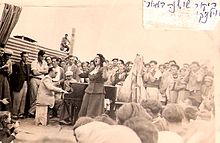- Cyprus internment camps
-
Cyprus internment camps were camps run by the British government for internment of Jews who had immigrated or attempted to immigrate to Mandatory Palestine in violation of British policy. The camps operated from August 1946 to January 1949 and in total held about 51,000 persons.[1]
Contents
Background
In the White Paper of 1939, the British government decided that future Jewish immigration to Palestine would be limited to 75,000 over the next five years, with further immigration subject to Arab consent. At the end of World War II, there were still 10,938 immigration certificates remaining but the five years had expired.[2] The British government agreed to continue issuing 1,500 certificates per month, but the influx of Jews, especially from the displaced person camps in Europe, well exceeded that number.[2] It was decided in August 1946 to hold many of the illegal immigrants on Cyprus.[2] Previous places of detention had included Atlit detainee camp in Palestine, and a camp in the Mauritius.[1] A few thousand refugees, mostly Greeks but also a "considerable number" of Jews from the Balkans, had reached Cyprus during the war years.[3]
Operation
 Moshe Vilenski playing piano, and Shoshana Damari singing, entertaining people in DP camps in Cyprus (ca. 1947–48)
Moshe Vilenski playing piano, and Shoshana Damari singing, entertaining people in DP camps in Cyprus (ca. 1947–48)
At its peak there were nine camps in Cyprus, located at two sites about 50km apart. They were Caraolos, north of Famagusta, and Dekhelia, outside of Larnaca.[4] The first camp, at Caraolos, had been used from 1916 to 1923 for Turkish prisoners of war.[5]
The majority of Cyprus detainees were intercepted before reaching Palestine, usually by boat.[5][1] Most of them were Holocaust survivors, about 60% from the displaced person camps and others from the Balkans and other East European countries.[1] They were mostly young, 80% between 13 and 35, and included over 6,000 orphan children.[1] A very small group of Moroccan Jews was also in the camps.[1]
From November 1946 to the time of the Israeli Declaration of Independence in May 1948, Cyprus detainees were allowed into Palestine at a rate of 750 people per month.[1] During 1947-48, special quotas were given to pregnant women, nursing mothers, and the elderly.[1][4] Released Cyprus detainees amounted to 67% of all immigrants to Palestine during that period, and 40% during the war months of May-September 1948.[1] The final group of detainees, 11,000 in number, immigrated to Israel in January–February 1949.[1] About 2000 children were born in the camps.[1]
The American Jewish Joint Distribution Committee (the "Joint") provided most of the detainee's needs, including welfare and medical aid, two nurseries, and extra food rations.[4] The Jewish Agency sent teachers and social workers from Palestine[4] but refused to give direct aid to the detainees on the grounds that it would grant legitimacy to the camps.[6]
Conditions in the camps were very harsh, with poor sanitation, over-crowding, lack of privacy, and shortage of clean water being the main complaints.[4] The local Joint director Morris Laub considered that the German prisoners of war housed in adjacent camps were treated better.[7]
In popular media
The 1960 film Exodus, adapted from the book of the same name by Leon Uris, starts with the arrival of Jews in a camp. The presence of Palestine volunteers is also shown.
Ruth Gruber documents the daily life of Jewish detainees and conditions in the camps of Xylotimbu and Caraolos in her book Exodus 1947: The Ship that Launched a Nation.
The book series "Promise of Zion" by Robert Elmer references the camps as the main character avoids being captured with other Jews on board a ship, and again when he returns to Cyprus in search of his mother. The camps' living condition are described in more detail here.
References
- ^ a b c d e f g h i j k Dalia Ofer. "Holocaust survivors as immigrants - the case of Israel and the Cyprus detainees". Modern Judaism 16: 1–23.
- ^ a b c Arieh Kochavi (1998). "The Struggle against Jewish Immigration to Palestine". Middle Eastern Studies 34: 146–167.
- ^ Bernard Wasserstein (1979). Britain and the Jews of Europe 1939-1945. London: Institute of Jewish Affairs. p. 329. ISBN 019822604.
- ^ a b c d e Rakafet Zalashik and Nadav Davidovitch (2006). "Measuring adaptability: Psychological examinations of Jewish detainees in Cyprus internment camps". Science in Context 19: 419–441.
- ^ a b Ulvi Keser (2009). "Turkish assistance activities for the Jewish immigrants and Jewish immigrant camps in Cyprus during Second World War". Ege Academic Review 9: 735–758. (includes list of boats)
- ^ Irith Zertal (1998). From catastrophe to power: Holocaust survivors and the emergence of Israel. University of California Press. pp. 209–210. ISBN 9780520215788.
- ^ M. Laub Last Barrier to Freedom page 25
- Source: N. Bogner, The Deportation Island: Jewish Illegal Immigrant Camps on Cyprus 1946-1948, Tel-Aviv 1991 in Hebrew.
- Source: D. Schaary, The Cyprus Detention Camps for Jewish "Illegal" Immigrants to Palestine 1946-1949, Jerusalem 1981 in Hebrew.
- Source: M. Laub, Last Barrier to Freedom, Internment of Jewish Holocaust Survivors on Cyprus 1946-1949, Berkeley 1985
- Encyclopaedia Judaica: Articles: Cyprus, Illegal Immigration (1971)
- Searching for memories in the soil: Cyprus Mail, Nathan Morley (2011)
Categories:- Aliyah
- British Mandate for Palestine
- History of Israel
- Jews and Judaism in Cyprus
- Aftermath of the Holocaust
- Internment camps
- Refugee camps
Wikimedia Foundation. 2010.

